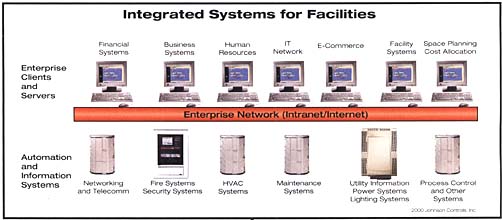Predictions are usually risky, but here's one that could give fortune tellers a good name: the meaning of systems integration is about to undergo a transformation. |
John
Murphy Article
originally published |
AutomatedBuildings.com
|
[an error occurred while processing this directive] |
Predictions are usually risky, but here's one that could give fortune tellers a good name: the meaning of systems integration is about to undergo a transformation. |
John
Murphy Article
originally published |
 Over
the past several years, the phrase has referred to the integration of building
systems including temperature, lighting, security and fire, resulting in
enhanced functionality for the facility operator, as well as lower
installation and operating costs for the building owner.
Over
the past several years, the phrase has referred to the integration of building
systems including temperature, lighting, security and fire, resulting in
enhanced functionality for the facility operator, as well as lower
installation and operating costs for the building owner.
While that meaning -- and the demand for that level of integration -- is not going away, a higher-level definition is starting to circulate, also driven by customer needs: core systems integration at the enterprise level. It refers to integrating building systems with an organizationís financial systems, human resource systems and IT networks. In other words, integration now encompasses all the systems that monitor, manage and control enterprise operations.
The goal is to seamlessly integrate all of the necessary information to manage the entire enterprise. From this perspective, integration has an impact on revenue as well as functionality and costs.
For any business where constant uptime is critical to success, enterprise level integration offers an invaluable tool. For example, a telecommunications provider wants to be able to tie its building automation system into its network management system so managers know when the network is at risk due to environmental factors such as temperature, humidity, fire, power outages or fluctuations.
[an error occurred while processing this directive]The applications extend beyond telecommunications, to every enterprise with mission-critical production or delivery systems, from the new economy to the old -- computer chip manufacturers, on-line businesses, hospitals. Customers and increased competition are driving managers to seek a more comprehensive, real time view of the performance of their enterprise. High-level core systems integration provides an important piece of that, helping management teams make better informed and more timely decisions on how to deploy their assets.
Through integration, those assets will work harder for you. When the human resources database, complete with security-level rosters, is linked to the facilityís access control system, duplicate data entry is eliminated. Plus, secure assets remain secured even when employees work evenings or weekends. The traditional HVAC infrastructure can be exploited to deliver more value-added services such as remote monitoring and service dispatch; data collection and reporting; performance benchmarking; and energy systems management that helps companies control usage and negotiate supply.

High-level integration makes your management systems work together more effectively, in ways that enhance your enterprise. A retailer can tie people-counting sensors into the HVAC system, achieving more efficient indoor climate modulation. The result: a more comfortable store environment that enhances a customersí shopping experience, and sales.
A headquarters operation can tie its scheduling system for meetings and conference rooms into the building automation system so that the lights go on in a reserved room right before the meeting starts, and heating/cooling is automatically adjusted for the number of people scheduled to meet. The result: a more productive work space, and lower energy costs.
The facilitating technology for integration is not a single, homogeneous network, but open protocols and communication gateways between networks that permit the sharing of information. Making that information easily accessible through a single "window" so that managers can use it is another critical piece. Increasingly, this window will be a web browser providing access to real time information anywhere in the world.
The market for this level of integration is already creating partnerships and alliances of both traditional and non-traditional system providers. Itís easy to see why. This is truly a case where 1 + 1 + 1 equals more than 3.
[an error occurred while processing this directive]
[Click Banner To Learn More]
[Home Page] [The Automator] [About] [Subscribe ] [Contact Us]